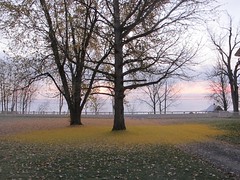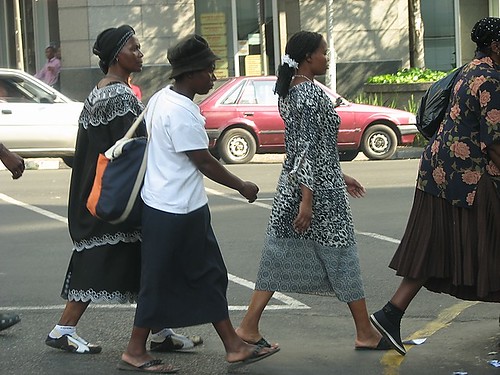
Yesterday Linda Hollier (@lindahollier) put me on to “a new concept: a metro flaneur!” A what?!?! Of course, she had me at flaneur (What is a flaneur?), so I headed on over to Shoba Naraya’s post,”Solution to urban isolation: become a Metro flaneur“. The article, looking inside of the much anticipated opening of Dubai‘s Metro Gren Line, pits enthusiasts against indifferent Dubaians. She’s sympathetic to the former, helpful to the latter. Her wonderful waterfall of flaneurial advice flows from her friend Ria’s question: “And what would I do on the Metro?”
I have three words for her: be a flaneur. As the essayist Alain de Botton says, flaneurs stand in deliberate opposition to the two imperatives of modern society: to be in a hurry and to buy things. Flaneurs do neither. They stroll and saunter; eavesdrop on conversations; watch people, wonder who they might be, and construct narratives about their lives. All this is possible on a train. Even better, your environs are air-conditioned and spanking clean. The Metro provides a convivial, civilised way to be a flaneur. (The National)
I couldn’t have answered any better myself! Though her words, her advice, her logic are oh-so familiar.
I remember discovering the metro trains and buses in Washington, DC as a college undergraduate. Fair to say I was an unusual freshman in plenty of ways, but one was that I’d wander the city for hours, sometimes entire days on busses and metros. No, not to commute. Not even to get somewhere specific, not always at least. If you haven’t ridden public transportation in Washington, it’s worth trying. Impeccably clean. Efficient. Safe. Well layed out. And well used. It’s this last merit of the metro system that attracted me the most. People. So many people, and so many different kinds of people. I was most familiar with NYC where the subways, although fascinating in their own right, are often filthy, sometimes a bit unfriendly and even a bit more crime prone (think pick pockets). In DC it was so civilized. I felt safe. Safe enough to ride all day on a rainy Sunday learning my way around the city and observing my fellow travelers. I began to record my observations, “found poetry” I called it. Narrative sketches and fragments of dialogue… I even mused over the direction people faced when traveling, positing a theory that those who selected forward-facing seats were commuters, racing off to their next commitment. While those content to face backward – to watch where they’ve been instead of where they were going – were travelers, tourists, joy riders. Somewhere in a ratty notebook there’s a poem to this effect, though I’ll have to bury it if/when I ever unearth it.
Naraya dishes on whether or not a handful of countries/cultures are flaneur-centric or even flaneur-likely, but it is her reflection on the origin and nature of flanerie that I find appealing:
It was the French poet Charles Baudelaire who came up with the word “flaneur” to describe the attitude that he thought we should adopt while walking the streets… sauntering… eying the women walking by and enjoying the drama of the streets… [taking the time] to observe, imagine and gossip… Great cities of the world engender people’s hopes and aspirations. To plunge into Piccadilly, Fifth Avenue, Boulevard Saint-Germain, or Paradeplatz is to feel part of a great and variegated group of beings who are both similar to us and intensely different. Being in a public place is an exercise in subsuming the ego for the pleasures of being a part of the great tide of humanity. Sitting together on a subway allows people of different classes to mix and even decompress together. Soon, commuters will start talking, sharing stories and chores.(The National)
Intoxicating idea. Addictive occupation. I believe that many feel the flaneurial tug, but most have trained themselves to resist the siren-call in the name of focus, discipline and productivity. Fair enough. No doubt these ambitious souls are accomplishing and producing more than I. But at what cost? And not just to themselves. Is the race to the swift? Sometimes. But not always. And even when it is, is the race worth winning if you’ve missed the swish-swish-swish of the tedder raking the freshly cut hay into labyrinthine mounds for the hay bailer? If you’ve missed the smell of freshly drawn sap being boiled into maple syrup? If you’ve missed the feel of cool water against your skin while skinny dipping in Lake Champlain, swimming in the shimmering moonbeam? If you’ve missed the sight of three pheasants chicks breaking out of their shells in a corner of the back meadow?
In addition to Naraya’s article Hollier shared a blog post that she’d written a year ago to commemorate the passing of a date which intrigued her. There is much to ponder this fellow flaneur’s thoughtful post, but it’s her train reflection which offers the most apt and eloquent denouement for this morning’s rumination on the metro flaneur.
09.09.09 is a special day in Dubai’s history. It sees the opening of the Dubai metro which has taken 49 months, 30,000 workers and Dh28 billion to achieve. It will be the world’s longest automated driverless rail system and this new system… will no doubt have far-reaching effects on the lives of all who live here… As I think about the metro, I think too of my late father whose love for trains and railways finds itself somehow continued within me. As Dubai’s first Metro train rolls out of the station today, another page of history will be turned. I am one passenger on the train of life. Today is one station along the way. Today is my birthday. I feel privileged to be on this train. (Integral Life)
Why should you take the metro? What would you do on the metro? Be a flaneur. At least once in a while.
Related articles
Like this:
Like Loading...














